Distance: 20 NM/Time: 10.5 hrs
The first night at anchor here in the Matanzas River had been fairly straightforward. There was a pretty big tidal current–I’d say 2-3 knots–which shifted every six hours. It was so strong because the mouth of the river (emptying into the Atlantic) was just 1/2 mile downstream. The bow would more or less point in the direction the current was coming from, so the boat would swap directions every six hours. This didn’t create any problems, and the wind was more or less down the long axis of the boat, too, so I had a very comfortable breeze through the boat regardless of the tides.
Last night, though, was a completely different story. Both the winds and the tidal current were stronger. There had been gusty winds and rain showers coming through all day, and while the rain had stopped in late evening, the winds picked up. At their peak for a few hours, they were 22 knots gusting to 30, and I think because of the nearly full moon, the tides were higher, and so the current stronger.
Either way, the boat was not riding well. As the night progressed, it just couldn’t seem to keep still! It would swing one way, then back again 180 degrees the other way, then 90 degrees to the wind, then do a complete 360. It was very strange, and I couldn’t figure out what was causing it. The wind gusts were also causing the boat to rock a bit. All in all, it was a lot more…violent than the previous night, so much so that as the gyrations and spinning became more and more pronounced, I was beginning to worry that the strain might cause the anchor to break free and drag. So starting around midnight, I got out of bed and started an anchor watch.1
I also decided to clean up the cockpit. The entire contents of the port locker were spread all over the cockpit. I previously had to remove the sealable PVC pipe that I kept the oil change hand pump tubes in (so they don’t drip oil all over everything), and of course, it was at the bottom of everything, which is why I had to empty the locker. But, as this was all spread out, it had rained and gotten everything wet while I was changing the oil. I had then planned to just to leave everything out overnight to dry out a bit before repacking it in the morning. I knew I would have time in the morning because I didn’t need to get to St. Augustine until 1:00 pm (at slack tide) and it was only and hour and a half trip.
But, now I wanted all this stuff out of the way. If the anchor started dragging, it was going to be challenging enough to deal with it single-handed without a bunch of gear blocking movement in the cockpit. Grabbing a headlamp, I loaded everything back into the locker. Then I ran through in my head what I would need to do quickly if the anchor started dragging (turn on the engine blower, fuel pump, windlass, GPS, radio, depth sounder, autopilot, grab a headlamp, get up to the helm and start the engine, then go from there).
After all that was settled, I decided to try to catch up on my blog on my computer while I monitored the boat’s movement on the anchor alarm app. This is what it looked like:
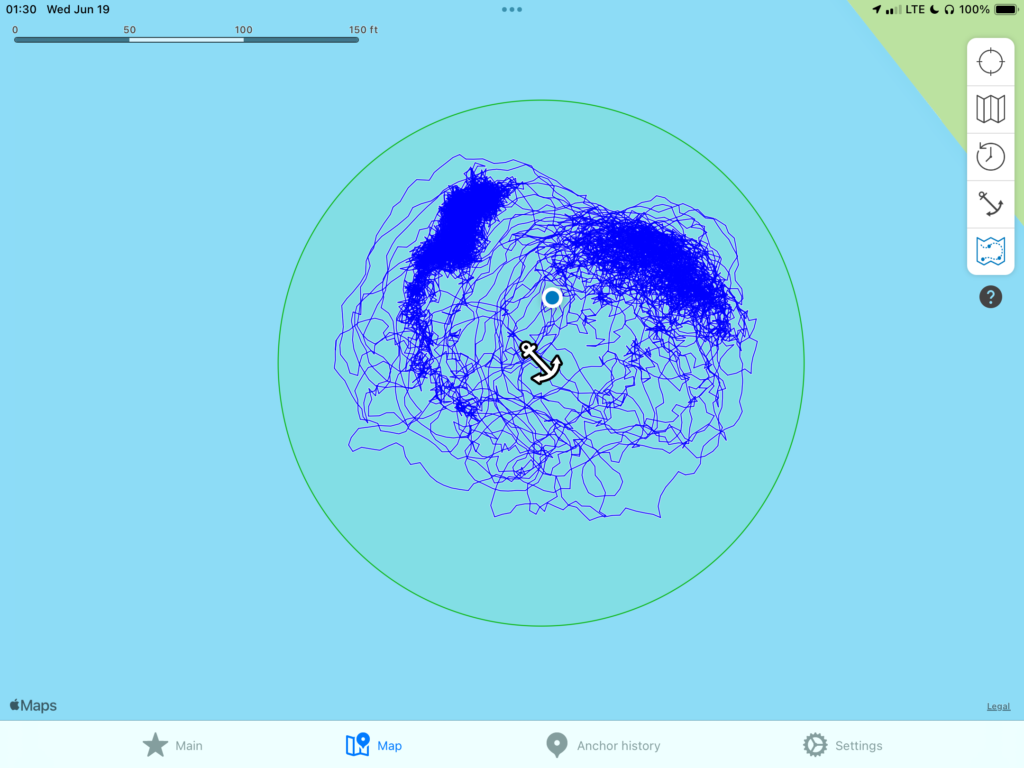
This showed the boat’s position history since I had set the anchor two days before. (The dot is the boat’s current position according to the iPad’s GPS). The two big “clouds” show the movement of the boat the first night–the two position switches that happened each tide change, as I mentioned. That is pretty normal. But all the other threads had been just tonight, and showed pretty clearly the kind of crazy motions the boat was undergoing. I had about 75 feet of rode out in 13 feet of water, for at least a 5:1 scope, all chain. I had set the initial alarm distance just beyond that length (the circle above). As long as the boat didn’t move towards (or beyond) that circle, everything was good. Uncomfortable maybe, but the anchor was still holding.
About an hour and a half later, the winds actually moderated a bit and the boat settled down. Finally (I thought) I might be able to sleep! But as I sat there watching it, the blue dot started slowly (over a period of a minute or so) moving past the normal “cloud” toward the edge of the circle, until it actually touched the circle and set off the anchor alarm. I initially then just increased the radius of the circle (because it’s always sort of a guess when placing the anchor’s position in the app initially, so I thought I might be off 15 or 20 feet.) But the dot kept moving (slowly) the same way until finally there was no doubt that Serendipity was dragging anchor. This was right after a tidal change and the boat had settled down with both the wind and the current coming from the same direction. (The same thing had happened every six hours over the last two days.) So, why it would start dragging now was a mystery. I switched over to my chartplotter app and verified that we were now about 125 feet from where I had dropped the anchor. It agreed with my anchor alarm app: We had already drug 50 feet!
The good news was that we were dragging away from shore. Had I been drifting toward the shore, it would have been a panic situation requiring immediate action. But as it was, I could watch and wait, knowing I had almost 500 feet before I went aground on the opposite shore. For the next hour, the anchor alarm slowly painted this picture:
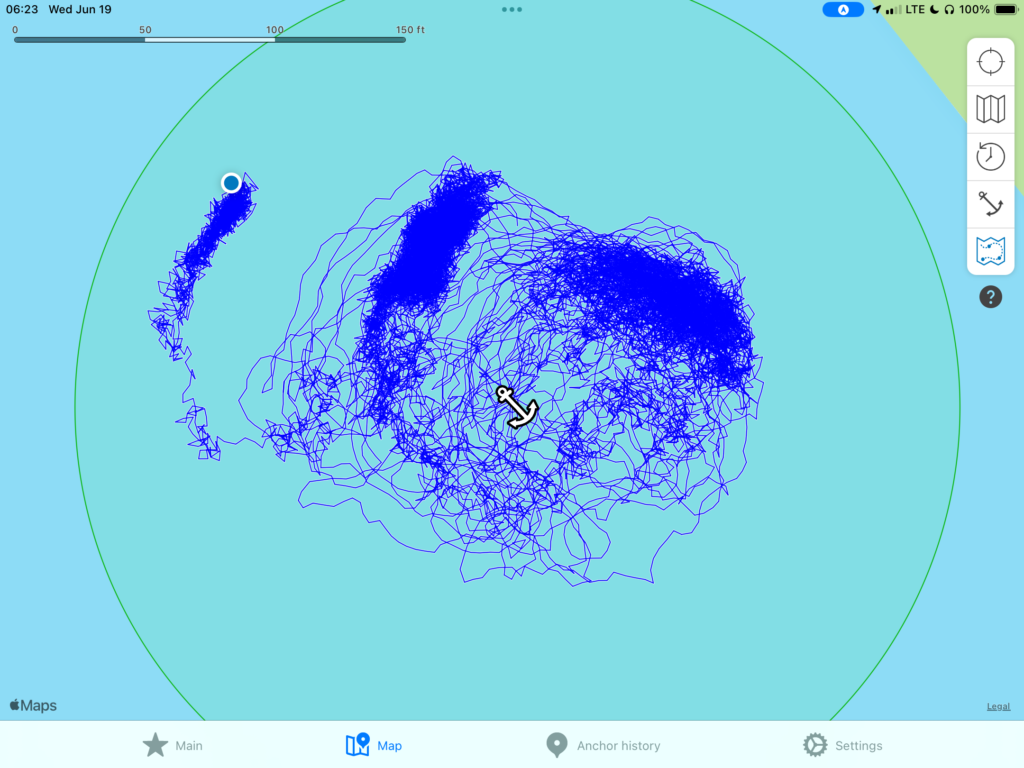
You can see that I expended the circle a lot to encompass the boat’s new position (to keep the alarm from going off). With the winds now down to more like 15 knots and the boat’s gyrations ended, I observed the boat holding position for another hour or so until I was pretty certain the anchor had reset and was now holding again. But, wanting some redundancy, I set an anchor alarm on my iPhone, too, and hit the sack around 3 am.
But, I also set an alarm for 6:00 am. This was because I realized that it would be very difficult to weigh anchor when the winds and the current were opposing. Picture the current running underneath the boat from the stern to the bow, held that way by the wind coming from the bow. The anchor chain would stretch underneath the boat to the anchor which was 40 feet or so behind the boat! To weigh the anchor is such circumstances I would have to try to back up the boat into the current while bringing in the chain. My boat does not back up in a straight line–it has a mind of its own in reverse–so that would have been an absolute nightmare, especially single-handed, not being able to see from the cockpit which way I needed to steer the boat toward the anchor. As it was, the current and the wind were coming from the same direction–the southeast–so the chain was out in front of the boat where the anchor was 75 feet away. It would be much more simple to just motor forward slowly while bringing in the chain. But this situation would change at 7 am, when the tide changed again. I didn’t want to wait for slack tide, because that was when the boat seemed to be the most squirrelly, thus my 6 am alarm.
I woke at twilight with about 3 hours of sleep under my belt and prepped the boat to get underway. The boat had thankfully remained stable, and weighing anchor by putting the boat in gear aimed forward, actually worked pretty well and without incident.
As I turned north at idle speed to head for St. Augustine, I saw 4.5 knots on the GPS. At idle! My ETA into the marina was showing 8 am! The current must be at least 3 knots. Normally, I’d love such a thing. Bring the engine up to cruise RPM and scoot along at 8.5 knots. But, it wouldn’t do to get to St. Augustine until 1 pm! How was I going to kill five hours! I really didn’t want to motor in circles off the marina, so started looking for anchorages enroute. But I also didn’t want to end up in the same situation from which I had just extricated myself!
For a vessel with my draft, there were only two appropriate anchorages en route to St. Augustine. One was subject to a lot of fetch2 and would not have been any less comfortable than what I had just left. (The winds had picked back up to about 20 knots, gusting to 25.) The remaining anchorage, called Alcala, had very mixed reviews. Earlier reviews ranted and raved about it, but more recent ones said that it had shoaled over and was too shallow to get into.
At this point I felt that I didn’t really have a choice. I was exhausted after such a night and little sleep, and motoring around in circles for another five hours getting even more tired before facing what was likely to be a challenging docking at the marina didn’t seem wise. (The marina had a lot of fetch being on the downwind side of the ICW and was reporting winds of 30 mph.)
So, I very slowly and very carefully motored into the dubious anchorage, made a big circle around what I planned to be my anchoring area checking the depth sounder the entire way. And, it was all fine. Plenty of water, and fairly sheltered. It would do! Relief! I anchored without an issue and went below to try to sleep for a couple of hours.
I had one of those sleeps where, when you get up you’d swear that you never actually fell asleep. But it was two hours later, so I guess I did, although I really didn’t feel very rested. Actually, it was because I was stressed about getting in and out of St. Augustine marina. I’m new to handling this boat, very new to being single-handed, and with the winds going to be pushing me hard against the fuel dock, it would be hard not to slam into it (depending on how many other boats were there) and very difficult to get off of after refueling and doing the other errands I had to do there.
I decided to get as much “intel” as I could, so called to marina to confirm when they thought the slack tide would be, find out how crowded they expected it to be, etc. I was glad I called because the dockhand told me that slack tide today was going to be at 2 pm–not 1 pm as my app said. He also highly recommended getting there at slack tide as it could be very difficult other times. So now I had yet another hour to kill! But, he also said that it was completely empty because of the time of year and because “not many people are wanting to be out boating today in 30 mph winds.” So at least, I thought, I would probably have the dock to myself. (Alas, that was not to be.)
So, I fuddled about getting some food into me, doing the dishes and some other chores and even laid down again just to rest my body while waiting to leave around noon. I decided I wanted to arrive there at 1:30 pm instead of 2:00 pm as he suggested, just in case he was wrong and my app was right; I would split the difference. I could handle motoring around for 30 minutes if I were early.)
I weighed anchor the same way I did back at Mantazas: Put the boat in gear at idle facing the direction the anchor was, then run up to the deck with the windlass remote and retrieve the anchor as the boat slowly puts slack into the chain. By carefully managing the windlass, I could use it to “steer” the boat toward the anchor without putting too much strain on the windlass. When the snubber connection got to the top, I’d have to run back to the cockpit, put the boat in neutral, then go back forward to remove the snubber. Then back to the cockpit, put the boat in gear, back up front, and retrieve the remaining chain and anchor. This system seemed to work well for weighing anchor with a strong wind/current, so it will be my technique for now. It is also great exercise. 🙂
I departed the anchorage with once again the current whisking me along on the now 5-mile trek to the St. Augustine Municipal Marina. On the way, I was slowly passed by two cabin, cruiser-type boats (who, for a change, called me on the radio to warn me they were passing, then slowed down as they passed to reduce their wake). As I followed them toward St. Augustine, I hoped that they weren’t going there, too, because if so, they would inevitably stop at the fuel dock before either getting a slip or continuing on.
En route, I stowed the solar panels in the down position, rigged up the starboard dock lines (planning to come into the dock facing any remaining current), and put the fenders on deck.
Sure enough, as they approached St. Augustine, both boats called the marina requesting the (previously empty) fuel dock! Urghhh. It was like the marina in Daytona all over again when I had to orbit to wait for inbound boats which came out of nowhere as I was nursing a boat with a defective engine into port. Sure enough, here in St. Augustine, I also had to orbit for about 10 minutes to allow the other boats to get secured to the fuel dock after which I had a much smaller target to aim for!
It was a bit difficult dealing with the northbound 2-knot current at this point and an easterly wind that was blowing about 20 knots. I didn’t do too bad, but did bump against the dock, earning a black scuff mark from the dock bumper. (I didn’t feel too badly about it after watching other boats, not-single-handed and with bow thrusters, hitting harder than I did!) Nonetheless, I was very relieved to be tied up and safe with no damage to my boat (or nearby boats)!
I topped off the main tank and three jerry cans, then dumped my waste oil at their repository ashore and stopped by the dockmaster’s office/boater’s lounge to see if my packages were still there. Luckily they were. But, I had to endure a lecture by the dockmaster about ordering stuff when I wasn’t actually at the marina. I told him that I had called the office prior to doing so, and was told it was okay. He obviously didn’t believe me and got snarky and said that in the future, nothing should be ordered until I was at the marina. I asked, “What if I’m only staying here for a couple of days?” and he replied, “Then maybe this isn’t the place for you.” Whatever. I thanked him anyway for watching over my packages.
Heading back to my boat, I was disappointed to discover that I was now sandwiched between a 50′ sailboat and an 80′ yacht. I expressed to the dock hand my trepidation at trying to get off the dock successfully with a 20-knot wind holding me against it. (Luckily, we were now at slack tide, so no current.) He assured me, “Well just keep a stern line on you, have you reverse to pull the bow away from the dock, then go forward. We’ll get you out by the next bridge opening.” (The Bridge of Lions drawbridge was immediately north of the marina and only opened on the hour and half-hour.)
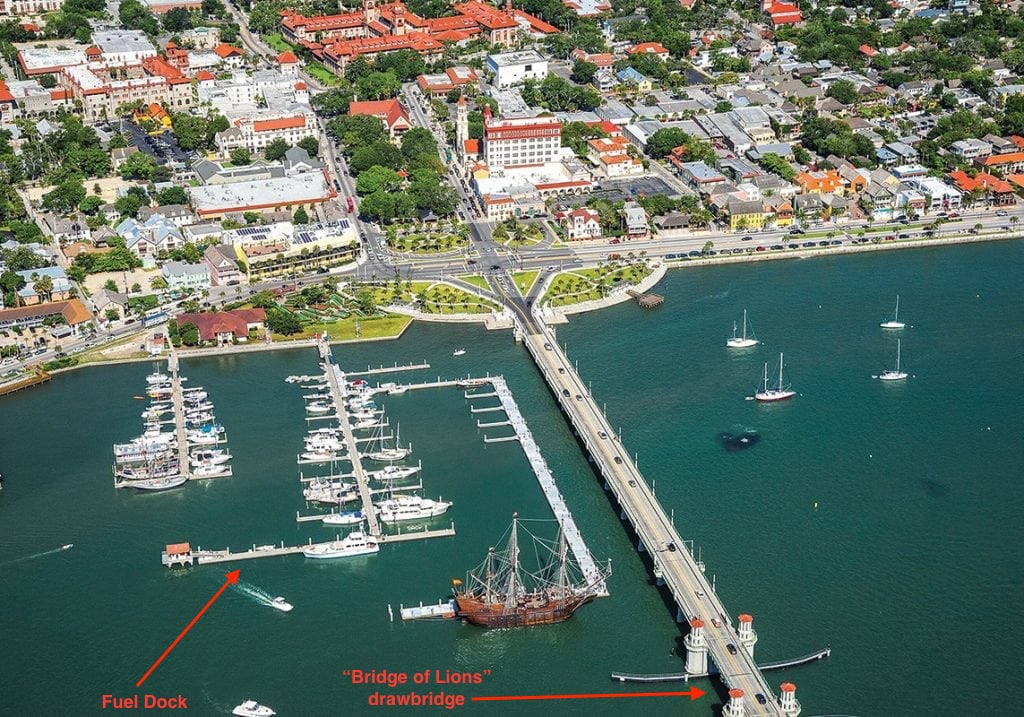
I was doubtful. I knew how much my bow was affected by the wind. I’d experienced times previously, in lesser winds, when I had been unable to turn the boat into the wind to port. The other sailboat was only about 20 feet ahead of me. I could easily see my bow refusing to turn into the 20 knots of wind and Serendipity colliding with it.
Luckily, it was only making a quick fuel stop then heading out to the mooring field.3 So, I told the dockhand that I wasn’t in a hurry and would wait until the sailboat had departed. That would give me a clear “run” of a couple hundred feet to get away from the dock. I decided I would try his technique and if it didn’t work, could always then try one of mine.
I watched closely as he set up the other sailboat for the same kind of departure he planned for me. It was an abortion! And that boat had a bow thruster.4 Although, to tell the truth, the skipper really didn’t seem to understand the physics of it all. He was using the thruster at the wrong time, didn’t understand that he needed to switch from reverse to forward without delay, etc. They eventually swung so far the other way (bow in) that he just ended up reversing out away from the dock. Okay, now my turn. At least I felt I understood the physics of the maneuver.
So, as all the lines were cast off except my starboard stern line, I reversed as one dockhand pushed my bw out as far as he could reach (while another dock hand tended to my stern line). Both my reversing and his pushing managed to get the bow out about 20 degrees, so I threw it in forward, as the second dock hand cast off my stern line, and I gradually worked my way against the wind and away from the dock. Success! And, there was NO WAY I would have cleared that other sailboat using that technique.
But I was FREE! with a full fuel tank, my packages, an engine that was now apparently running fine, and enroute to what was supposed to be a very nice anchorage only and hour and a half away. I was very happy and relieved. The sun had come out, it was a lovely day, oh, and the bridge was going to open in only five minutes. Life was good!
The voyage to the anchorage was lovely. I had the incoming current at my back (once I got north of the St. Augustine Inlet–which looked very ugly5–and so was able to make good time. I had originally planned to stop at Pine Island anchorage, a bit further north, because Nicholay and I had stopped there in his boat, Mexicana when we were moving it from North Carolina to Florida and liked the shelter it had provided.
However, in December, the winds had been out of the north-northeast, but today they were out of the east. Pine Island provided shelter for the former but not the latter. The one I was aiming for was called “Mile 769”. It had a nice, forested island on its east side, which would be perfect. And, it was beautiful. I was the only boat there, set my anchor like I had done earlier in the day, and was settled in by 4:30 pm ready for some serious rest!
Later the sun came out, making it even more beautiful!
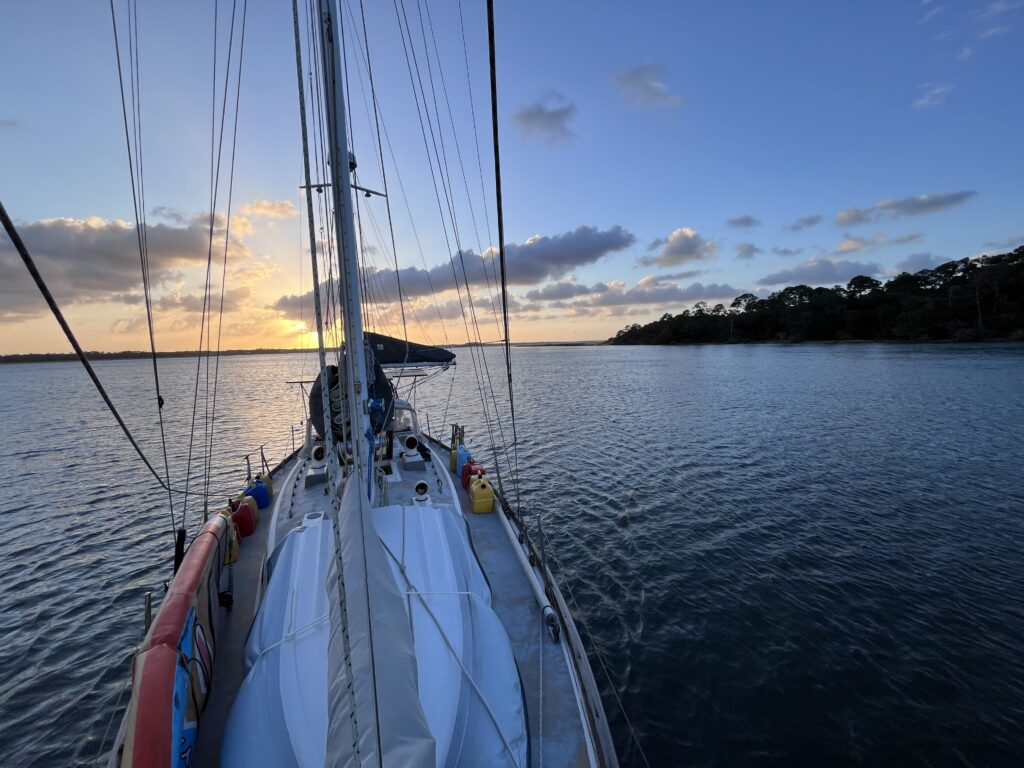
Of course, nothing is perfect, and I didn’t get to enjoy the evening as much as I would have liked because when setting my anchor I noticed that the chain had to be helped over the anchor roller even though the winds were strong enough that the backward push on the boat should have been pulling it out easily. A closer look revealed that the entire roller was disintegrating!
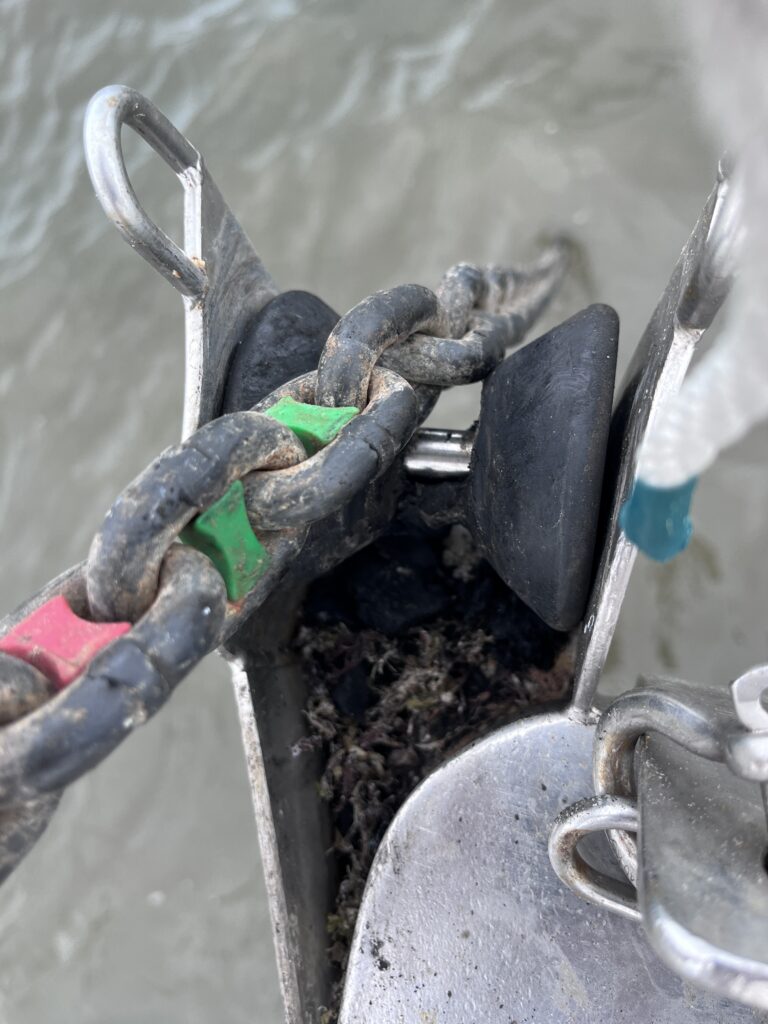
And, it was brand new. What the heck?! I managed to get the anchor set by pulling the anchor chain by hand over the roller, but knew this needed to be fixed. When single-handed, there were times when I depended on the chain coming out by itself as I was maneuvering the boat from back in the cockpit. Luckily, when replacing this roller a month or so ago, I had ordered a spare, and so put that on, a 15-minute job. Problem solved (temporarily?) But the question still remained: why had this rubber roller come apart? I needed to find out.
So, I went to my #1 best source for all things nautical: Nicholay. I sent him that photo and he asked: Is that a Delrin anchor roller, or a rubber bow roller for a boat trailer? Huhhhh? Uh, is…there…a…difference? I guess I better check my Amazon “previous orders” to see what I got. Rubber bow roller. I thought it was for an anchor roller, but it was just the rubber piece the bow is held against when on a trailer! Doh!! Delrin or similar plastics were what was appropriate and much stronger. Drats. Now I needed to order one of these. And quickly, because this one had only lasted a few weeks. I was anchoring a lot (many times a day, it seems!), and knew this replacement wouldn’t last long.
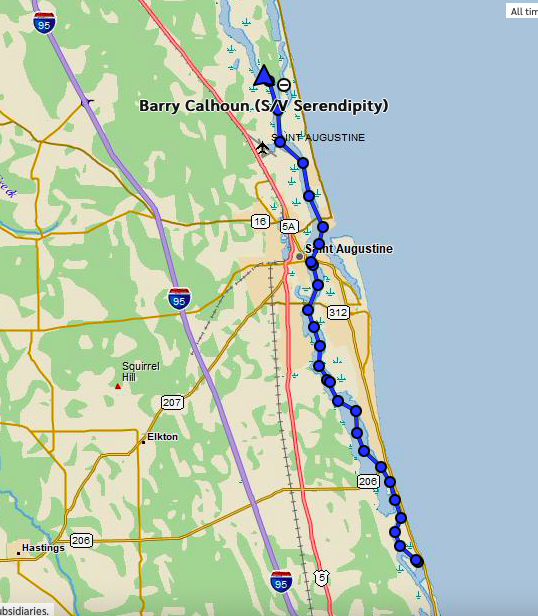
But, that would have to wait until I could get into a marina again. That probably meant Brunswick, GA, a couple of days further north. I’d worry about it tomorrow. Because I had already decided after such a crazy and busy night and day, that I was going to just stay at this anchorage for another day and relax. So, I took a shower on deck (using my trusty little camp shower),
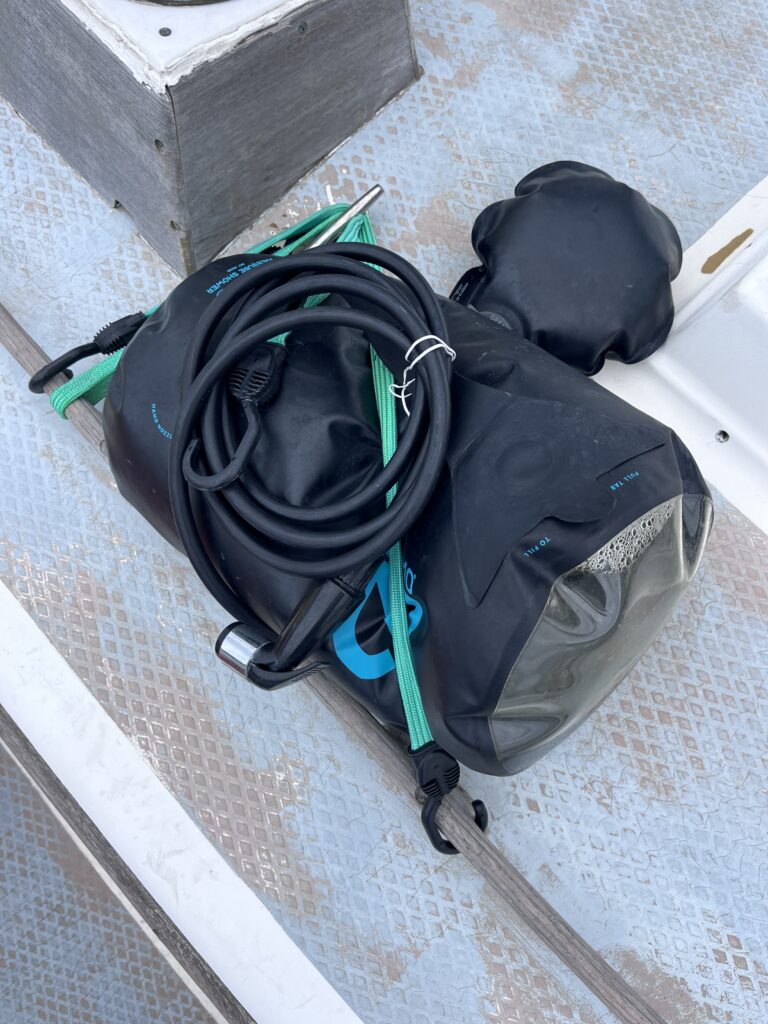
made some delicious pesto chicken and pasta, and hit the sack in a much more comfortable and beautiful anchorage than any so far.
- An anchor watch is just what it sounds like: Someone awake and paying attention to the anchor situation so that if it drags, action can be taken to prevent the boat from going aground or drifting into nearby boats. This includes options such as letting out more rode to increase the anchor’s scope, weighing and resetting the anchor somewhere else (to find a better holding bottom), or in severe cases where the conditions don’t allow either of the former, starting the engine and either weighing and leaving the anchorage or just motoring in place into the wind to try to take some load off the anchor. ↩︎
- Fetch, in this context, is the distance over which the wind has a chance to act on the water to make waves. With the same wind speed, the farther it has to interact with the water, the bigger waves it will cause (up to a limit). This is why the water is calm right on the edges of a lake, but rough in the middle. The closer one can tuck one’s boat up to a barrier in the wind’s direction (like trees), the smoother that water will be. Conversely, if there are a few miles between the boat and such protection, there will be a lot of waves, which not only makes the ride less comfortable, but can also put strain in the anchor if one is on the hook. ↩︎
- A mooring field is an organized set of permanent anchors with a floating ball with a line at the surface of the water. It makes for a very secure anchoring, and many more boats can be squeezed into a smaller area than if they all anchored separately. Marina’s often offer both slips in the marina or mooring balls (which are much less expensive, but include all the privileges of the marina such as showers, laundry, etc.)
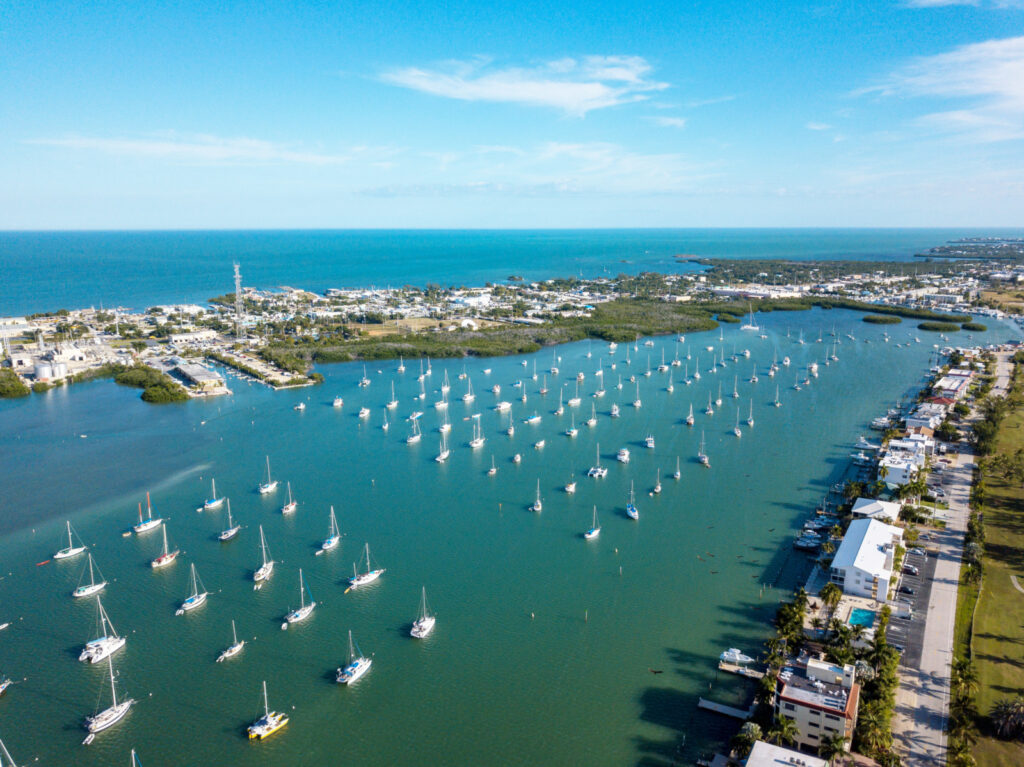
Mooring field at Boot Key Harbor in Marathon.
↩︎ - A bow thruster is a propeller built into the bow of a boat, aiming sideway, which can push the bow either left or right to help maneuvering in tight spaces. ↩︎
- In fact, I listened to an entire SOS on channel 16 for a boat that was taking on water, caught in the rollers in the inlet. Make me miss being in the Coast Guard! (The people were rescued by a fellow boater, but it seems the boat was lost. The sea is merciless.) ↩︎